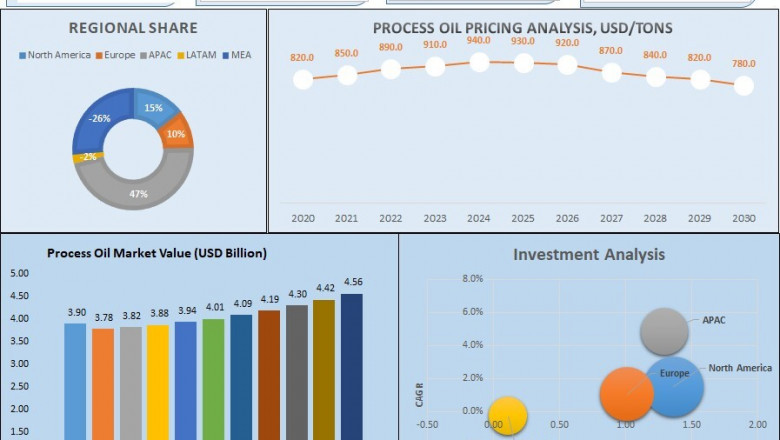views
The process oil market is gaining strong momentum, propelled by its increasing usage in the manufacturing of rubber products, personal care items, textiles, and polymers. As industries demand high-performance oils for blending, plasticizing, and enhancing product characteristics, the market is experiencing consistent growth across key sectors.
Market Growth and Key Statistics
The global process oil market was valued at USD 4.8 billion in 2023 and is projected to reach USD 6.7 billion by 2030, growing at a CAGR of 4.8%. Growth is driven by rising demand in the automotive, cosmetics, and industrial rubber industries, particularly in emerging markets like India, China, and Southeast Asia.
Key Factors Driving Market Growth
1. Expanding Automotive and Tire Industry
-
Process oils are crucial in rubber processing for tire manufacturing, offering flexibility and durability.
-
With global vehicle production expected to surpass 100 million units by 2030, demand for rubber-based components is accelerating.
2. Surge in Personal Care and Cosmetic Applications
-
In the cosmetics industry, process oils are used in lotions, creams, and baby oils for their emollient and lubricating properties.
-
The global personal care market, valued at over USD 500 billion, presents an expanding use case for refined, non-carcinogenic oils.
3. Growth in Polymer and Textile Manufacturing
-
Non-toxic process oils improve plasticity in TPEs, PVC, and other polymers, aiding in the production of consumer goods and packaging materials.
-
The textile industry relies on process oils for fiber lubrication and fabric softening during production.
Challenges in the Process Oil Market
1. Environmental and Health Regulations
-
Regulatory restrictions on aromatic oils due to potential carcinogenic properties are forcing a shift toward paraffinic and naphthenic alternatives.
2. Volatility in Crude Oil Prices
-
As process oils are petroleum-derived, fluctuating crude prices significantly impact production costs and profitability.
3. Sustainability and Waste Management
-
Growing concerns about sustainability and the carbon footprint of mineral-based oils are leading to demand for bio-based alternatives, though these come at a higher cost.
Regional Insights
-
Asia-Pacific dominates the global process oil market, accounting for over 40% of total demand, with rapid industrialization and robust rubber manufacturing in countries like China, India, and Thailand.
-
North America and Europe are shifting toward environmentally friendly, low-aromatic oils, driven by REACH and EPA guidelines.
-
The Middle East & Africa region is also growing steadily due to increased investment in the automotive and industrial sectors.
Future Outlook
The process oil market is poised for sustainable growth, supported by eco-friendly innovations, rising demand in automotive and personal care applications, and a global shift toward low-toxicity oils. Companies investing in bio-based and high-performance formulations will be best positioned for long-term success.
At Mark & Spark Solutions, we offer strategic insights to help you navigate dynamic industrial trends and capitalize on high-growth market segments.
Check out the full report for in-depth insights:
https://marksparksolutions.com/reports/process-oil-market
Company Information
Company Name: Mark & Spark Solutions
Email: sales@marksparksolutions.com
Phone: +1-585-374-1088














Comments
0 comment